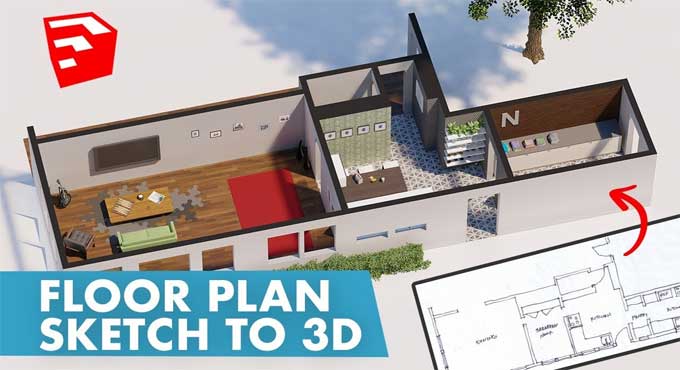Convert a Floor Plan to 3D with SketchUp

In this sketchup tutorial, we will show you exactly how to take a floor plan sketch and turn it into a 3D model in Sketchup.
How to import File?
The image can be downloaded or you can use your drawing. Simply choose the image you wish to use and click on 'file' > 'import'. You must select 'image' in the 'use image as' options. Then click the 'import' button.
How to Scale Image?
The image can be scaled based on the measurement you know when using one of your images. Otherwise, we can assume that the doors are 36 inches wide. Select the tape measure tool on one side of the wall and click from one side to the other. Once you have typed 36", press 'enter'.
How to lock your Image?
If you don't want the image to move, you will have to lock it. You can select an image by double-clicking it, followed by right-clicking to make a group. Select lock by right-clicking again.
Modeling a floor plan into a 3D Model
The Floor Drawing
You can trace the floor with the line tool starting at the reference point. If you have precise measurements, type those in for each line. If you are drawing something without measurements, use the line tool to draw a line, and if possible round to the nearest inch or foot. You can close off the last corner by holding shift on the axis and clicking on your reference point.
Painting
The original image can be unlocked by right-clicking and selecting unlock. The paint bucket tool can be opened by hitting B. Next, hold down alt while clicking the eye dropper and clicking the original image. You can now paint the floor group you just drew. The original image can be deleted now since your floor already contains all the details of the plan.
Creating Slab Floor
You'll start by making the slab floor in your sketch. You can extrude it down 8 inches with the push/pull tool by clicking on the floor.
Drawing Wall
There are two types of wall in a floor plan. There are: Interior Wall and Exterior Wall.
Interior Wall
The interior walls can be traced in the same manner as the floor outline. You should use whole numbers unless you know the exact measurements.
Exterior Wall
Copy the floor, exit the group, and then choose ?edit' > 'paste in place'. You can use the offset tool, type in seven to offset the exterior walls using the floor.
Increment changing
If your measurements are rounded to whole numbers, you may find it helpful to adjust the increment settings. Then, you click on the "units" tab after selecting "window" > "model info." You can select 0 in the "precision" dropdown.
Close Line
It is a good idea to shut off every line as you go along. This can be made a lot easier with the Edge Tools2 plug-in by Thom-Thom. Using the 'edge tools' option of 'tools' > 'find edge gaps', you will be able to quickly locate any gaps in the drawing.
Extrude Wall
Once you have all your walls drawn, you can use the push or pull tool to extrude them. If you aren't sure how high the walls are, you can use 8 feet as a guideline. You can click on your walls and choose the push or pull tool to type in 8. Click twice on your other walls to make them the same height with the push or pull tool.
Adding Door Frame
6' 8" is the standard height for door frames. You should type 6' 8" on the base of the door frame you are currently using. Create a line from 6' 8" up. Then, follow that line across the wall's width. The shape should be copied and extruded to the other side of the door frame. Any extra lines can be erased using the eraser tool. You can paste the header shape that you copied to the rest of the door frames. If you have extra lines, you can use the push or pull tool to remove them.
Changing the View
When you want to view from the top-down again, select camera > standard views > top. The "parallel projection" option should select under the camera dropdown. You need to unhide the imported sketch.
Adding Windows
Adding the windows will complete the conversion to 3D. You will note that you can no longer see the window openings when you view the parallel projection view. The sketch can be brought to the top or opacity decreased as a solution. It is also possible to leave the sketch below your model. You can change the opacity of each wall.
Selecting the top of the walls
Select the materials tab from the default tray. From the dropdown, choose the colors you want. Paint the top of the walls using the paint bucket in the color of your choice. Reduce opacity using the opacity slider on the materials tab. You can use the paint bucket tool to paint the bottom of the walls and lower their opacity.Your model should now show the plan underneath it. Using the line as a guide, trace the edges of the windows, and then copy and paste them along the wall so they all look the same.
From the 3D view
You draw a line across the bottom of the window to determine the sill height. With the eraser tool, you can remove the lines at the bottom of the screen. If you wish to create an opening for the windows, you can push or pull them through.
Adding the Final Details
Your finalized floor plan can convert into a 3D model by adding doors, windows, and appliances now. It is possible to use the 3D Warehouse with your models.



